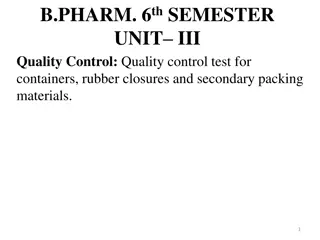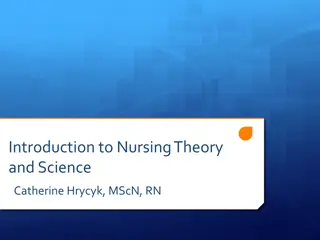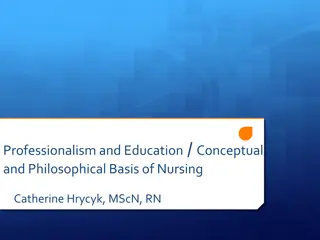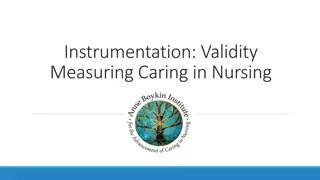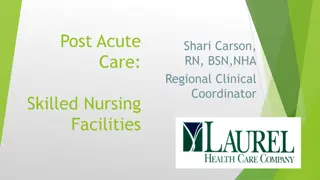Understanding the Impact of Nursing Home Closures
Nursing home closures are becoming more frequent due to various factors such as consumer preferences and government policies. The lack of adequate laws and oversight can lead to negative impacts on residents, including transfer trauma and self-care deficits. This article delves into the challenges faced during nursing home closures and the need for better policies to minimize adverse effects on residents.
Download Presentation

Please find below an Image/Link to download the presentation.
The content on the website is provided AS IS for your information and personal use only. It may not be sold, licensed, or shared on other websites without obtaining consent from the author. Download presentation by click this link. If you encounter any issues during the download, it is possible that the publisher has removed the file from their server.
E N D
Presentation Transcript
WHEN NURSING HOMES CLOSE: LEARN THE FEDERAL RULES Part 2 December 12, 2017 Dr. Cynthia Rudder, Founder and Former Executive Director, Long Term Care Community Coalition Lori Smetanka, Consumer Voice Alisha Lineswala, Consumer Voice This project is funded by the Retirement Research Foundation.
Agenda Introduction Alisha Lineswala, Public Policy & Program Specialist, Consumer Voice Project Overview & Closure Recommendations Dr. Cynthia Rudder, Project Researcher and Trainer Documentation, Notice, Orientation, and Administrator Duties Alisha Lineswala, Public Policy & Program Specialist, Consumer Voice Closure Plans, Policies and Procedures Lori Smetanka, Executive Director, Consumer Voice Q & A Closing Lori Smetanka, Executive Director, Consumer Voice
NURSING HOME CLOSURES ARE BECOMING MORE FREQUENT Both consumer preference for care in a community setting and state and federal government policy have driven these closings.
OVERVIEW Resident stress of moving is occurring nationwide, and may be due to the fact that the closure of nursing homes seems to be inadequately addressed in state and federal laws and regulations and/or poor oversight and monitoring by states and the federal government. When closures are inevitable, better policies and practices can be implemented to minimize the negative impact, including transfer trauma, on residents.
NEGATIVE IMPACTS OF NURSING HOME CLOSURE Transfer trauma (also referred to as "relocation stress syndrome") Self-care deficits - Impaired ability to perform or complete activities of daily living for oneself, such as feeding, dressing, bathing, toileting.
Depression, sometimes manifesting as agitation Increase in withdrawn behavior
Falls Weight loss
WHAT ARE THE EXPERIENCES OF NURSING HOME CLOSURES NATIONWIDE?
WE DECIDED TO CONDUCT A NATIONAL STUDY TO FIND OUT.
NATIONAL STUDY FUNDED BY THE RETIREMENT RESEARCH FOUNDATION Using online surveys and one-on-one interviews: OBJECTIVES: Identify obstacles Identify policies and procedures for overcoming the obstacles Identify best practices Make recommendations Click here to view the full report.
RESULTS: OBSTACLES TO A SUCCESSFUL CLOSING Lack Of Appropriate And Nearby Placements Poor Discharge Planning Lack Of Communication Poor Notice/Not Enough Time Staffing Issues Transfer Trauma
STUDY RECOMMENDATIONS Click here for the full report: http://theconsumervoice.org/uploads/files/ issues/CV_Closure_Report_- _FINAL_FINAL_FULL_APPENDIX.PDF
MAJOR FINDING: Many local and some state ombudsmen did not know the federal or their state nursing home closure rules. MAJOR RECOMMENDATION: Educate all ombudsmen.
DOCUMENTATION 483.15(c)(2) Facility must ensure that the transfer or discharge is documented in the resident s medical record and appropriate information is communicated to the receiving health care institution or provider. Documentation Requirements: Must include reason for the transfer Must be made by the resident s physician
DOCUMENTATION Information provided to the receiving facility must include at a minimum: Contact information of practitioner responsible for the resident Resident representative information, including contact information Advanced Directive information Special instructions for ongoing care Comprehensive care plan goals All other necessary information, including a copy of the resident s discharge summary and any other documentation to ensure a safe and effective transition of care
NOTICE 483.15(c)(3) Notify the resident and the resident s representative(s) of the transfer or discharge and the reasons for the move in writing and in a language and manner they understand. Facility must also send a copy of the notice to a representative of the Office of the State Long-Term Care Ombudsman. Contents of the Notice Must Include: The reason for transfer or discharge; the effective date of transfer or discharge; the location to which the resident is transferred or discharged A statement of the resident s appeal rights, including the name, address (mailing and email), and telephone number of the entity which receives such requests; and information on how to obtain an appeal form and assistance in completing the form and submitting the appeal hearing request.
ORIENTATION 483.15(c)(7) A facility must provide and document sufficient preparation and orientation to residents to ensure safe and orderly transfer or discharge from the facility. This orientation must be provided in a form and manner that the resident can understand.
ADMINISTRATOR DUTIES 483.70(l)(1)-(2) Administrator of the facility must submit to the State Survey Agency, the State LTC ombudsman, residents of the facility, and the legal representatives of such residents or other responsible parties, written notification of an impending facility closure. The administrator must also ensure that the facility does not admit any new residents on or after the date on which such written notification is submitted.
ADMINISTRATOR NOTICE Interpretive Guidance: 483.70(l) The facility s notifications should be developed with input from the facility s Medical Director and other management staff It must include a summary of key details from the closure plan for the safe and orderly transfer, discharge and adequate relocation of all residents
TIMING OF NOTICE 483.70(l)(1)(i)-(ii) For voluntary or State-mandated closures, the required written notification must not be later than 60 days prior to the date of such closure. If the Secretary terminates the facility s participation under this title (involuntary), notification must be provided no later than the date that the Secretary determines appropriate.
CONTENTS OF THE NOTICE 483.15(c)(5) The notice must include: the name, address and telephone number of the State LTC ombudsman for residents with developmental disabilities, the mailing address and telephone number of the agency responsible for the protection and advocacy of developmentally disabled individuals established under Part C of the Developmental Disabilities Assistance and Bill of Rights Act for residents with mental illness, the mailing address and telephone number of the agency responsible for the protection and advocacy of individuals with mental illness established under the Protection and Advocacy for Mentally Ill Individuals Act Interpretive Guidance for 483.70(l): contact information for the primary facility contact(s) responsible for the daily operation and management of the facility during the facility s closure process
ORAL NOTICE Interpretive Guidance: 483.70(l) In addition to written notification, facility staff should discuss (orally) this information with residents, their families and/or legal representatives in order to provide a better understanding of the situation and their rights. Notice of facility closure to residents and their legal or other responsible parties must be provided in a language and manner they understand.
FACILITY WILL NOT CLOSE & INFORMATION PROVIDED TO RECEIVING FACIILTY Interpretive Guidance: 483.70(m) The facility will not close until all residents are transferred in a safe and orderly manner to the most appropriate setting in terms of quality, services, and location, as available and determined appropriate by the resident s interdisciplinary team after taking into consideration the resident s individual needs, choices, and interests. Each resident s complete medical record information including archived files, Minimum Data Set (MDS) discharge assessment, and all orders, recommendations or guidelines from the resident s attending physician must be provided to the receiving facility or other provider at the time of the resident s discharge or relocation.
CLOSURE PLANS LTC facilities must include in their closure notices a plan, approved by the State, for the transfer and adequate relocation of residents of the facility by a specified date prior to closure. The notices must include assurances that the residents will be transferred to the most appropriate facility or other setting in terms of quality, services, and location, taking into consideration the needs, choice, and best interests of each resident.
CLOSURE PLANS - Steps CMS expects that the closure plan would include sufficient detail to clearly identify the steps the facility would take, and the individual responsible for ensuring the steps are successfully carried out, such as: Assurance that no new residents will be admitted to the facility on or after the date that the written notice of impending closure was provided to the State Survey Agency.
CLOSURE PLANS - Steps The process and procedures for providing timely written notification of the facility s impending closure, including its closure plan to the State Survey Agency, the State s LTC ombudsman, residents, their legal representatives or other responsible parties - CMS Regional Office, State Medicaid Agency, staff, and the residents primary physicians. Also notification to employees, vendors, contractors, hospitals, union representatives, community partners, etc.
CLOSURE PLANS - Steps A process that provides for how the closing facility will identify available facilities or other settings in terms of quality, services, and location, taking into consideration the needs, choices, and best interests of each resident.
POLICIES To ensure resident safety, the plans should address: The Administrator s duties and responsibilities around notifications and assurances The primary contact(s) responsible for the daily operation and management of the facility during the facility s closure process. The roles and responsibilities of the facility s owners, administrator, or their replacement(s) or temporary managers/monitors during the closure process.
POLICIES The provisions for ongoing operations and management of the facility and it s residents and staff during the closure process that include: payment of salaries and expenses to staff, vendors, contractors, etc., continuation of appropriate staffing to meet the needs of all residents, continuation of resources to meet the needs of each resident including the provision of medications, services, supplies and treatments as ordered by the resident s physician/practitioner.
POLICIES ongoing accounting, maintenance and reporting of resident personal funds the provision of appropriate resident care information to the receiving facility to ensure continuity of care the labeling, safekeeping and appropriate transfer of residents personal belongings, such as clothing, medications, furnishings, etc. at the time of transfer or relocation including contact information for missing items after the facility has closed
Preparing Residents for Safe and Orderly Transfer Provisions for sufficient preparation and orientation to residents to ensure a safe and orderly move from the facility might include: interviewing residents and their legal or other responsible parties, where applicable, to determine each resident s goals, preferences, and needs in planning for the services, location, and setting to which they will be moved
Preparing Residents for Safe and Orderly Transfer offering each resident the opportunity to obtain information regarding their community options, including setting and location; providing residents with information or access to information pertaining to the quality of the providers and/or services they are considering; psychological preparation or counseling of each resident as necessary making every reasonable effort to accommodate each resident s goals, preferences and needs regarding receipt of services, location and setting
CMS Guidance Facility staff should make every possible effort to lessen transfer trauma for residents, which may include: Reviewing the resident s care routines, needs, and preferences with staff at the receiving facility who will be caring for the resident, and Assisting residents and or their representatives with obtaining information required to make an informed decision about facility relocation
FEDERAL RULES: ADMINISTRATOR SANCTIONS A civil monetary penalty of up to $100,000. A minimum of $500 for the first offense. A minimum of $1,500 for the second offense A minimum of $3,000 for the third and subsequent offenses. An administrator could be subject to higher amounts of CMPs (not to exceed $100,000) May be subject to exclusion from participation in any Federal health care program. Shall be subject to any other penalties that may be prescribed by law. Any sanctions that have been levied against an administrator would also be reviewed by the State s licensing agency for possible disciplinary action including suspension and termination of the administrator s license.
FEDERAL RULES: PAYMENTS When a notification is made the Secretary will continue to make payments to the SNF or, for a NF, to the State, as the Secretary considers appropriate, during the period beginning at the time the notification is submitted and until the resident is successfully relocated. 488.450(c)(2)
Contact Information Cynthia Rudder crnhcc@aol.com Lori Smetanka lsmetanka@theconsumervoice.org Alisha Lineswala alineswala@theconsumervoice.org







